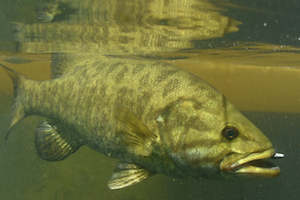Smallmouth Bass Autumn Fishing

The most important thing to remember about fall and winter fishing is that Smallmouth Bass are slow to move and feed. As the water drops below 50°F/10°C, they become lethargic and as the water cools even further, they enter a semi state of hibernation which lasts until the spring.
Water Temperature Matters
With fall comes cooler temperatures and volatile weather conditions for much of North America.
Early fall offers cooler water from the high heat of summer, bringing smallmouth bass back to the shallow waters. However late fall, especially in the north, brings much cooler water forcing the smallmouth bass back into deeper water for another winter.
Changing weather patterns and cooler water can occur as early as September in northern parts on Ontario and as late as November in the southern United States such as Florida and Texas. When waters drop below 50°F, Smallmouth Bass move into deeper waters anywhere from 20 to 40 feet deep to feed on the crayfish and smaller fishes that have also moved into these deeper waters.
Finding Smallmouth Bass
Look for Smallmouth bass near deep drop-offs found near their summer feeding grounds. The same underwater features that provide cover can be found in deep water and this is where they can be found.
A sonar device is extremely helpful in locating them in late fall and winter.
Bait and techniques
- Start with back-trolling using a green or grey 1/4 ounce jig with an artificial grub, jigging bait or small spoon
- Live crayfish, worms and leeches are also highly effective
The best techniques to use during this time involve lures and baits that appeal to their instinct to defend themselves. Cast too close to the bass and they’ll be scared off. Cast within 2 to 3 feet of their location and reel in the lure within a foot or two of them.
- Crankbaits that act like a wounded fish are very effective.
- Move the jigs and crankbaits slowly when fishing in cold waters. Sometimes the fish only strike motionless bait that is barely suspended from the bottom.
- Adding a spoon or a spinner to a popular bait like a worm or a crayfish will entice a strike if it’s close to the bass.
- At depths of up to 40 feet/12 meters, use light bait casting equipment, a graphite or boron rod, and an 8 pound test line for the best control and response.



